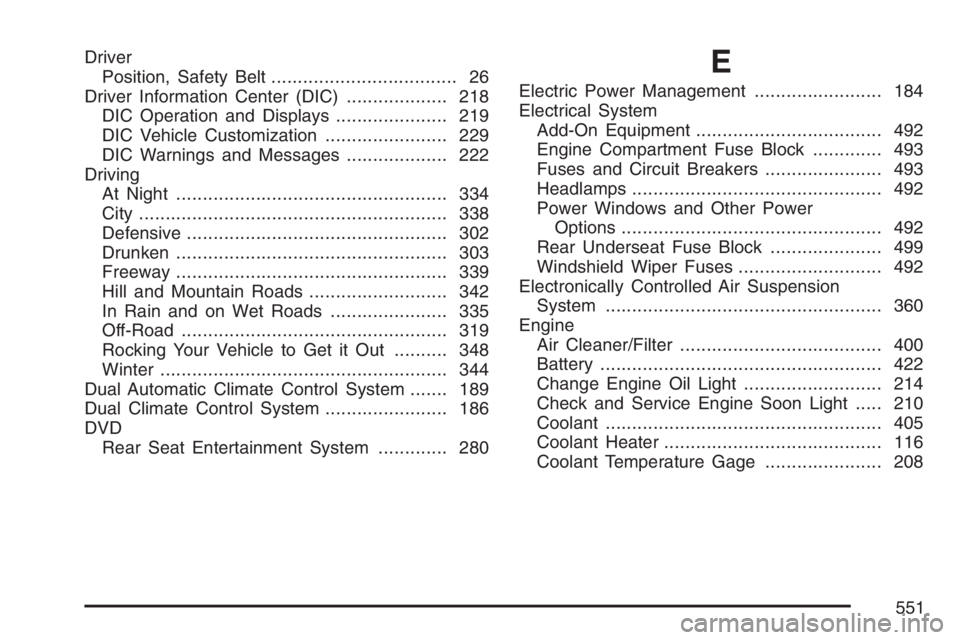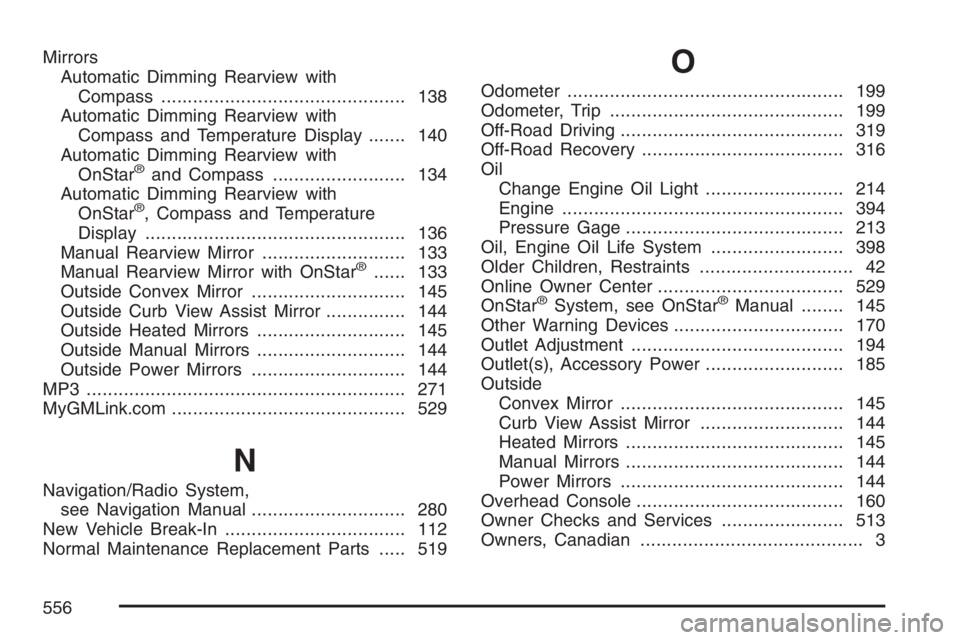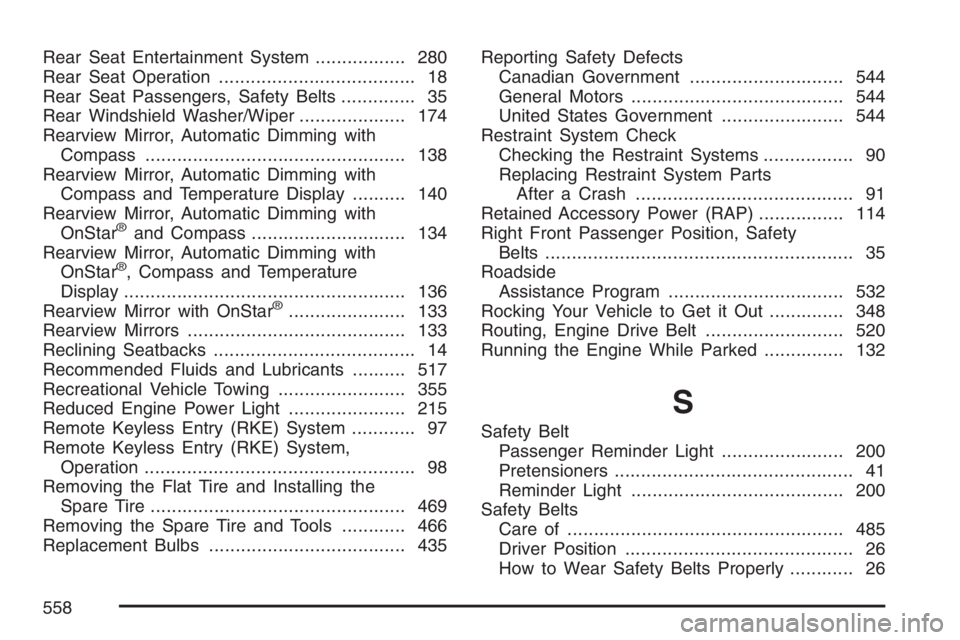display GMC ENVOY 2007 Owner's Manual
[x] Cancel search | Manufacturer: GMC, Model Year: 2007, Model line: ENVOY, Model: GMC ENVOY 2007Pages: 562, PDF Size: 3 MB
Page 408 of 562

Add coolant mixture at the recovery tank, but be
careful not to spill it.
{CAUTION:
You can be burned if you spill coolant on
hot engine parts. Coolant contains
ethylene glycol, and it will burn if the
engine parts are hot enough. Do not spill
coolant on a hot engine.
Occasionally check the coolant level in the
radiator. For information on how to add coolant to
the radiator, seeCooling System on page 411.
Radiator Pressure Cap
Notice:If the pressure cap is not tightly
installed, coolant loss and possible engine
damage may occur. Be sure the cap is properly
and tightly secured.
SeeEngine Compartment Overview on page 390
for information on location.
Engine Overheating
You will �nd a coolant temperature gage on your
vehicle’s instrument panel. SeeEngine Coolant
Temperature Gage on page 208for more
information.
If your vehicle has a Driver Information Center
(DIC), the display will show an Engine Coolant
Hot/Engine Overheated message. SeeDIC
Warnings and Messages on page 222for more
information.
408
Page 448 of 562

How to Check
Use a good quality pocket-type gage to check
tire pressure. You cannot tell if your tires are
properly in�ated simply by looking at them. Radial
tires may look properly in�ated even when
they’re underin�ated. Check the tire’s in�ation
pressure when the tires are cold. Cold means your
vehicle has been sitting for at least three hours
or driven no more than 1 mile (1.6 km).
Remove the valve cap from the tire valve stem.
Press the tire gage �rmly onto the valve to
get a pressure measurement. If the cold tire
in�ation pressure matches the recommended
pressure on the tire and loading information label,
no further adjustment is necessary. If the
pressure is low, add air until you reach the
recommended amount.
If you over�ll the tire, release air by pushing on
the metal stem in the center of the tire valve.
Recheck the tire pressure with the tire gage.
Be sure to put the valve caps back on the valve
stems. They help prevent leaks by keeping
out dirt and moisture.
Tire Pressure Monitor System
The Tire Pressure Monitor System (TPMS) uses
radio and sensor technology to check tire pressure
levels. TPMS sensors are mounted on each tire
and wheel assembly, except the spare tire.
The TPMS sensors monitor the air pressure in
your vehicle’s tires and transmit tire pressure
readings to a receiver located in the vehicle.
The TPMS is designed to alert the driver if a low
tire pressure condition exists. If your vehicle
has the Driver Information Center (DIC) steering
wheel control buttons, tire pressure levels
may also be checked through the DIC. See “Tire
Pressures” underDIC Operation and Displays
on page 219.
448
Page 449 of 562

When a low tire pressure condition is detected,
the TPMS will illuminate the low tire pressure
warning symbol located on the instrument panel
cluster, and at the same time a message will also
appear on the DIC display. The low tire pressure
warning symbol on the instrument panel cluster
and the CHECK TIRE PRESSURE warning
message on the DIC will appear at each ignition
cycle until the tires are in�ated to the correct
in�ation pressure. For additional information and
details about the DIC operation and displays
seeDIC Operation and Displays on page 219and
DIC Warnings and Messages on page 222.
You may notice, during cooler weather conditions,
that the tire pressure monitor light, located on
the instrument panel cluster, and the CHECK TIRE
PRESSURE message will appear when the
vehicle is �rst started, and then turn off as you
start to drive the vehicle. This could be an
early indicator that the tire pressures are getting
low and need to be in�ated to the proper pressure.
Each tire, including the spare (if provided),
should be checked monthly when cold and in�ated
to the in�ation pressure recommended by the
vehicle manufacturer on the vehicle placard or tire
in�ation pressure label.(If your vehicle has tires of a different size than the
size indicated on the vehicle placard or tire in�ation
pressure label, you should determine the proper tire
in�ation pressure for those tires.)
As an added safety
feature, your vehicle
has been equipped with
a tire pressure
monitoring system
(TPMS) that illuminates
a low tire pressure
telltale when one
or more of your tires
is signi�cantly
under-in�ated.
Accordingly, when the low tire pressure telltale
illuminates, you should stop and check your tires
as soon as possible, and in�ate them to the
proper pressure. Driving on a signi�cantly
under-in�ated tire causes the tire to overheat and
can lead to tire failure. Under-in�ation also
reduces fuel efficiency and tire tread life, and may
affect the vehicle’s handling and stopping ability.
449
Page 452 of 562

5. Remove the valve cap from the valve cap stem.
Activate the TPMS sensor by increasing or
decreasing the tire’s air pressure for
10 seconds, then stop and listen for a single
horn chirp. The single horn chirp should sound
within 15 seconds, con�rming that the sensor
identi�cation code has been matched to this
tire and wheel position. If you do not hear the
con�rming single horn chirp, you will need to
start over with step number one. To let
air-pressure out of a tire you can use the
pointed end of the valve cap, a pencil-style air
pressure gage, or a key.
6. Proceed to the passenger’s side front tire,
and repeat the procedure in Step 5.
7. Proceed to the passenger’s side rear tire,
and repeat the procedure in Step 5.
8. Proceed to the driver’s side rear tire, and
repeat the procedure in Step 5.9. After hearing the con�rming horn chirp for
the driver’s side rear tire, check to see if
the TPMS warning light is still �ashing. If yes,
turn the ignition switch to LOCK to exit the
sensor matching process. If the TPMS warning
light is not �ashing, the �ve minute time
limit has passed and you will need to start
the process over beginning with Step 1.
10. Set all four tires to the recommended air
pressure level as indicated on the Tire
and Loading Information label.
11. Put the valve caps back on the valve stems
The spare tire does not have a TPMS sensor.
If you replace one of the road tires with the spare,
the SERVICE TIRE MONITOR message will be
displayed on the DIC screen. This message should
go off once you re-install the road tire containing
the TPMS sensor.
452
Page 517 of 562

Recommended Fluids and
Lubricants
Fluids and lubricants identi�ed below by name,
part number, or speci�cation may be obtained
from your dealer.
Usage Fluid/Lubricant
Engine OilEngine oil which meets
GM Standard GM6094M and
displays the American Petroleum
Institute Certi�ed for Gasoline
Engines starburst symbol.
GM Goodwrench
®oil meets all
the requirements for your vehicle.
To determine the proper viscosity
for your vehicle’s engine, see
Engine Oil on page 394.
Engine Coolant50/50 mixture of clean, drinkable
water and use only DEX-COOL
®
Coolant. SeeEngine Coolant
on page 405.
Hydraulic Brake
SystemDelco
®Supreme 11 Brake Fluid or
equivalent DOT-3 brake �uid.
Usage Fluid/Lubricant
Windshield
WasherGM Optikleen
®Washer Solvent.
Parking Brake
Cable GuidesChassis Lubricant
(GM Part No. U.S. 12377985,
in Canada 88901242) or lubricant
meeting requirements of NLGI #2,
Category LB or GC-LB.
Power Steering
SystemGM Power Steering Fluid
(GM Part No. U.S. 89021184,
in Canada 89021186).
Automatic
TransmissionDEXRON
®-VI Automatic
Transmission Fluid.
Key Lock
CylindersMulti-Purpose Lubricant, Superlube
(GM Part No. U.S. 12346241,
in Canada 10953474).
Chassis
LubricationChassis Lubricant
(GM Part No. U.S. 12377985, in
Canada 88901242) or lubricant
meeting requirements of NLGI #2,
Category LB or GC-LB.
517
Page 551 of 562

Driver
Position, Safety Belt................................... 26
Driver Information Center (DIC)................... 218
DIC Operation and Displays..................... 219
DIC Vehicle Customization....................... 229
DIC Warnings and Messages................... 222
Driving
At Night................................................... 334
City.......................................................... 338
Defensive................................................. 302
Drunken................................................... 303
Freeway................................................... 339
Hill and Mountain Roads.......................... 342
In Rain and on Wet Roads...................... 335
Off-Road.................................................. 319
Rocking Your Vehicle to Get it Out.......... 348
Winter...................................................... 344
Dual Automatic Climate Control System....... 189
Dual Climate Control System....................... 186
DVD
Rear Seat Entertainment System............. 280E
Electric Power Management........................ 184
Electrical System
Add-On Equipment................................... 492
Engine Compartment Fuse Block............. 493
Fuses and Circuit Breakers...................... 493
Headlamps............................................... 492
Power Windows and Other Power
Options................................................. 492
Rear Underseat Fuse Block..................... 499
Windshield Wiper Fuses........................... 492
Electronically Controlled Air Suspension
System.................................................... 360
Engine
Air Cleaner/Filter...................................... 400
Battery..................................................... 422
Change Engine Oil Light.......................... 214
Check and Service Engine Soon Light..... 210
Coolant.................................................... 405
Coolant Heater......................................... 116
Coolant Temperature Gage...................... 208
551
Page 556 of 562

Mirrors
Automatic Dimming Rearview with
Compass.............................................. 138
Automatic Dimming Rearview with
Compass and Temperature Display....... 140
Automatic Dimming Rearview with
OnStar
®and Compass......................... 134
Automatic Dimming Rearview with
OnStar
®, Compass and Temperature
Display................................................. 136
Manual Rearview Mirror........................... 133
Manual Rearview Mirror with OnStar
®...... 133
Outside Convex Mirror............................. 145
Outside Curb View Assist Mirror............... 144
Outside Heated Mirrors............................ 145
Outside Manual Mirrors............................ 144
Outside Power Mirrors............................. 144
MP3 ............................................................ 271
MyGMLink.com............................................ 529
N
Navigation/Radio System,
see Navigation Manual............................. 280
New Vehicle Break-In.................................. 112
Normal Maintenance Replacement Parts..... 519
O
Odometer.................................................... 199
Odometer, Trip............................................ 199
Off-Road Driving.......................................... 319
Off-Road Recovery...................................... 316
Oil
Change Engine Oil Light.......................... 214
Engine..................................................... 394
Pressure Gage......................................... 213
Oil, Engine Oil Life System ......................... 398
Older Children, Restraints............................. 42
Online Owner Center................................... 529
OnStar
®System, see OnStar®Manual........ 145
Other Warning Devices................................ 170
Outlet Adjustment........................................ 194
Outlet(s), Accessory Power.......................... 185
Outside
Convex Mirror.......................................... 145
Curb View Assist Mirror........................... 144
Heated Mirrors......................................... 145
Manual Mirrors......................................... 144
Power Mirrors.......................................... 144
Overhead Console....................................... 160
Owner Checks and Services....................... 513
Owners, Canadian.......................................... 3
556
Page 558 of 562

Rear Seat Entertainment System................. 280
Rear Seat Operation..................................... 18
Rear Seat Passengers, Safety Belts.............. 35
Rear Windshield Washer/Wiper.................... 174
Rearview Mirror, Automatic Dimming with
Compass................................................. 138
Rearview Mirror, Automatic Dimming with
Compass and Temperature Display.......... 140
Rearview Mirror, Automatic Dimming with
OnStar
®and Compass............................. 134
Rearview Mirror, Automatic Dimming with
OnStar
®, Compass and Temperature
Display..................................................... 136
Rearview Mirror with OnStar
®...................... 133
Rearview Mirrors......................................... 133
Reclining Seatbacks...................................... 14
Recommended Fluids and Lubricants.......... 517
Recreational Vehicle Towing........................ 355
Reduced Engine Power Light...................... 215
Remote Keyless Entry (RKE) System............ 97
Remote Keyless Entry (RKE) System,
Operation................................................... 98
Removing the Flat Tire and Installing the
Spare Tire................................................ 469
Removing the Spare Tire and Tools............ 466
Replacement Bulbs..................................... 435Reporting Safety Defects
Canadian Government............................. 544
General Motors........................................ 544
United States Government....................... 544
Restraint System Check
Checking the Restraint Systems................. 90
Replacing Restraint System Parts
After a Crash......................................... 91
Retained Accessory Power (RAP)................ 114
Right Front Passenger Position, Safety
Belts.......................................................... 35
Roadside
Assistance Program................................. 532
Rocking Your Vehicle to Get it Out.............. 348
Routing, Engine Drive Belt.......................... 520
Running the Engine While Parked............... 132
S
Safety Belt
Passenger Reminder Light....................... 200
Pretensioners............................................. 41
Reminder Light........................................ 200
Safety Belts
Care of.................................................... 485
Driver Position........................................... 26
How to Wear Safety Belts Properly............ 26
558